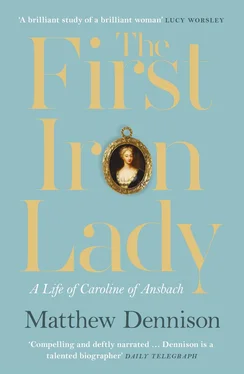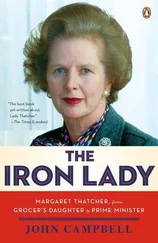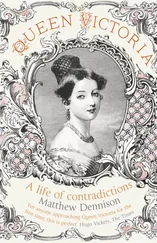If Caroline remembered anything of her early childhood, a period entrusted to the care of nurses and waiting women, her memories of her mother would have been of Eleonore’s near-continuous pregnancies. In January 1685 she gave birth to a son, christened Frederick Augustus, who died three weeks later. Within a year, a second son, William Frederick, was born. Then darkness fell. Two months after William Frederick’s birth, John Frederick died of smallpox. He was thirty-one years old. His remains were interred in the margraves’ vault in nearby St Gumbertus church. Caroline grew up with no memories of the father who died when she was three years old.
Eleonore became a widow at the age of twenty-three; she had been married four years. Six months later her father died in a hunting accident. For the grieving mother of two the darkness of Hollar’s townscape became a reality. John Frederick was succeeded by the elder surviving son of his first marriage, ten-year-old Christian Albert, who felt little warmth for the stepmother who could almost have been his sister, or for the stepsister whom he regarded as a baby. His minority left no role for Eleonore. Instead Elector Frederick III of Brandenburg acted as guardian to Ansbach’s underage margrave. He also provided a temporary home in Berlin for Caroline and William Frederick, in company with his gangly daughter Louise Dorothea and, from 1688, an ungovernable son, Frederick William. Alone, Eleonore retreated the short distance to a dower house in Crailsheim, south-west of Ansbach, a small medieval town of no distinction. Forced upon her by the terms of her marriage settlement and Christian Albert’s indifference, her withdrawal was a species of defeat. The uncertainty that was to be the keynote of Caroline’s peripatetic childhood began early.
At Crailsheim, Eleonore struggled for money. Unhappy and distracted, in the intervals when mother and daughter were reunited she neglected Caroline’s education. Penury made her fretful, threatened to overwhelm her. ‘She is a princess of great virtue and piety,’ noted the English diplomatist George Stepney, discussing Eleonore’s Lutheranism: her circumstances demanded the full resources of her faith. Stepney described her as ‘one who passes for a bigot in that persuasion’. 11Exigency is a hard taskmaster. Driven by anxiety, Eleonore was rumoured to have overcome her Lutheran bigotry to the extent of considering conversion to Catholicism in order to marry Maximilian II, elector of Bavaria, whose capital at Munich ‘excel[led] and out-dazzled[d] [all] for her elegant cleanliness’. 12Since the elector was married already, albeit to the fragile Habsburg archduchess Maria Antonia, who shortly died, this rumour – if it has any basis in truth – indicates the pitch of desperation Eleonore had reached. Understandably, her thoughts during the Crailsheim years were of escape by any means.
Through precocity, boredom or curiosity, Caroline took matters into her own hands and set about teaching herself to write. 13For the rest of her life, her sprawling, forward-tilting handwriting with its bold loops and lopsided incontinence betrayed the struggle it had cost her. She wrote ‘like a cat’, her husband protested, and could never spell in any language: ‘Choresbury’ for Shrewsbury, ‘Hamthuncour’ for Hampton Court, ‘Lady Bomffrit’ for Lady Pomfret – even the name of her closest lady-in-waiting was variously rendered as ‘Clayton’, ‘Claiton’ and ‘Klethen’. 14Her punctuation was erratic or non-existent, an oversight in the cat-like torrents. From the inky tangle emerges a vigorous quality to her character as well as the sharpness of her intelligence. It would not be reasonable, a Church of England bishop would comment later, ‘to measure the extent of her Royal Highnesses abilities by the common standard’. 15If handwriting is a guide, Caroline was determined, quick-witted, vehement, expressive.
Happily for Caroline’s future choices, Eleonore did not change her religion. When it happened, the remarriage of the widowed margravine served only to jeopardise her family’s wellbeing.
In November 1691, five years after John Frederick’s death, Eleonore travelled to Berlin at the invitation of Frederick III. On the eve of her thirtieth birthday she retained her good looks – ‘[a] beautiful person, the admiration of all who saw her’; 16unmistakeably she bore the imprint of grief, money worries and separation from her children. ‘She is handsome, well shaped but too lean,’ Stepney recorded. 17Weight loss won few plaudits at the end of the seventeenth century. Nevertheless, Stepney’s admiration can be inferred from the poem written in French that, despite their differences of rank, he subsequently addressed to Eleonore, and his assiduity in undertaking errands on her behalf. 18Eleonore appears poised and strikingly attractive in a portrait of the early 1690s, sumptuously swathed in ermine and heavy silks, every inch the baroque consort. But the outline of her face is less rounded than in John Frederick’s marriage portrait; ditto the fullness of that lovely décolletage.
Frederick III’s purpose in summoning his widowed kinswoman was Eleonore’s remarriage. His motive was neither altruistic nor prompted by affection. Improved relations between the mutually mistrustful electorates of Brandenburg and Saxony had recently been sealed symbolically by the inauguration by their rulers of a shared chivalric order, the Order of Sincerity. Frederick intended to consolidate diplomatic amity with a marriage between Eleonore and his Saxon counterpart, Elector John George IV. Her friendship with Frederick and his wife Sophie Charlotte of Brunswick-Lüneburg, and distant relationship, through her father, to the Saxon electoral family, ideally positioned Eleonore for the role of bridal pawn. In practice it proved a marriage of emotional barrenness and unusual acrimony, and spectacularly failed to benefit any of its key players.
The man who became the nine-year-old Caroline’s stepfather, in a service conducted with unceremonious haste at Leipzig on 17 April 1692, following a formal exchange of treaties on 10 February, was ‘round shouldered, of a sullen look, which … does not belie his humour … [and] of a saturnine temper’. He spoke little, ‘offer[ed] no jest himself and [was] not pleased when others [did] it’; his killjoy obstinacy was marked. 19So, too, his variable health, though he was six years younger than the bride who, by April, had seen enough to disabuse her of every romantic illusion. George Stepney described him as incapacitated by the smallest debauchery, but unable to resist the heavy drinking endemic in German courts; his kidney problems were well known. ‘I look upon him as a man that will not be long-lived,’ Stepney noted. Had Eleonore but known of it, this last observation would have constituted her single slender thread of hope in the nightmarish years to come. In the meantime, in Leipzig, ahead of the couple’s formal entry into the city of Torgau, their marriage was ‘consummated with such an air of debauchery’ that courtiers muttered their misgivings. Having ‘bedded his bride in her own apartments’, the sated but loveless John George abandoned her rooms for his own, returning to complete his night’s rest alone at five o’clock in the morning. 20
The emotions of Eleonore’s second husband could not have been more different from those of her first. John Frederick had delighted in his comely bride; John George’s affections were already engaged elsewhere and, in Stepney’s assessment, ‘his humour … quite contrary’. 21Stepney drew attention to the family’s poor record of marital fidelity, stretching back ‘two generations at least’. 22In John George’s case, he embarked on marriage under duress. Courtier and captious memoirist Baron von Pöllnitz described Eleonore in Saxony as ‘a Princess, whose excellent accomplishments gain’d a great veneration’. 23Not on the part of her new husband. John George’s intentions towards Eleonore extended no further than fulfilment of his conjugal duties. Stepney described her position unenviably as ‘not unlike Penelope or good queen Catherine [of Braganza] in the reign of Charles II’, a combination of abandonment and clutching after crumbs of affection. 24
Читать дальше












